From 1,000-year-old tree to natural hot spring: 5 S’pore spots to wow kids and spark learning
Sign up now: Get tips on how to help your child succeed
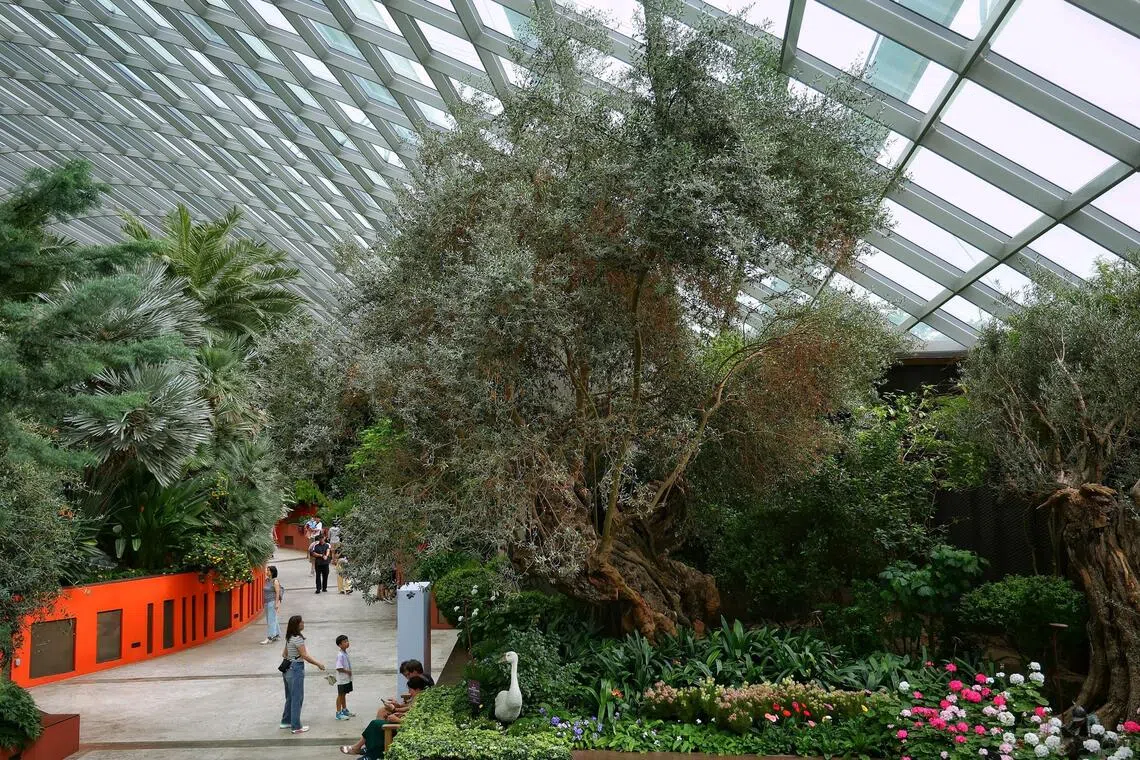
Visitors admiring the 1,000-year-old olive tree in the Flower Dome at Gardens by the Bay on Nov 5. It was imported from Spain in 2011.
ST PHOTO: KEVIN LIM
Follow topic:
SINGAPORE – Your kids are not just having fun when they explore, but they are also honing crucial skills such as critical thinking, creativity and problem-solving.
To bring out the explorer in children and foster curiosity, Dr Teo Chew Lee, deputy centre director from the Centre for Research in Pedagogy & Practice at the National Institute of Education, suggests creating an “idea wall” at home.
Encourage kids to write down their musings and dedicate time to discuss these with them regularly. You can also initiate discussions by asking questions about topics that pique their interests.
There are learning opportunities all around, from the comfort of home to the neighbourhood playground. Singapore also has many places where you can spark your kids’ enthusiasm for learning.
During family outings, it is crucial to strike a balance: Ask your children questions to stimulate their thinking, but also allow them ample space and time to explore on their own. The essence of experiential learning lies in igniting their excitement and curiosity, she adds.
While some, such as Gardens by the Bay, are well-known attractions, they still contain hidden surprises. Here are five of them.
1,000-year-old olive tree in the Flower Dome
Beyond the beautiful seasonal floral displays, the Flower Dome at Gardens by the Bay holds a fascinating secret: an olive tree which is more than 1,000 years old.
Imported from Spain in 2011, its precise age is unknown, but it already holds the distinction of being the oldest tree in the gardens.
Take a moment to observe this venerable olive tree with its silvery-green leaves, located near the entrance of Hortus restaurant.
Dr Teo suggests helping your children grasp its age by offering comparisons: “1,000 years old? That’s 100 times your age, 30 times mummy’s age and 15 times older than grandpa.”
Challenge them to spot 12 other olive trees in Flower Dome, the youngest of which is 120 years old.
According to Mr Mihkaail Ng, deputy director of conservatory operations at Gardens by the Bay, an ancient olive tree is notably characterised by the wide circumference of its trunk, also known as its girth.
Unlike younger trees, which receive monthly care, the 1,000-year-old olive tree in the Flower Dome is maintained weekly. The horticulturists inspect this tree fortnightly, more often than the quarterly inspections for other trees.
Where: Flower Dome, Gardens by the Bay, 18 Marina Gardens Drive str.sg/wXt8D
MRT: Bayfront/Gardens by the Bay
Admission: For Singapore residents, tickets are priced at $12 for adults and $8 for children aged three to 12, and senior citizens aged 60 and above. While admission charges apply, free 15-minute guided tours are available on selected dates
Info:
‘$5 tree’ in the Singapore Botanic Gardens
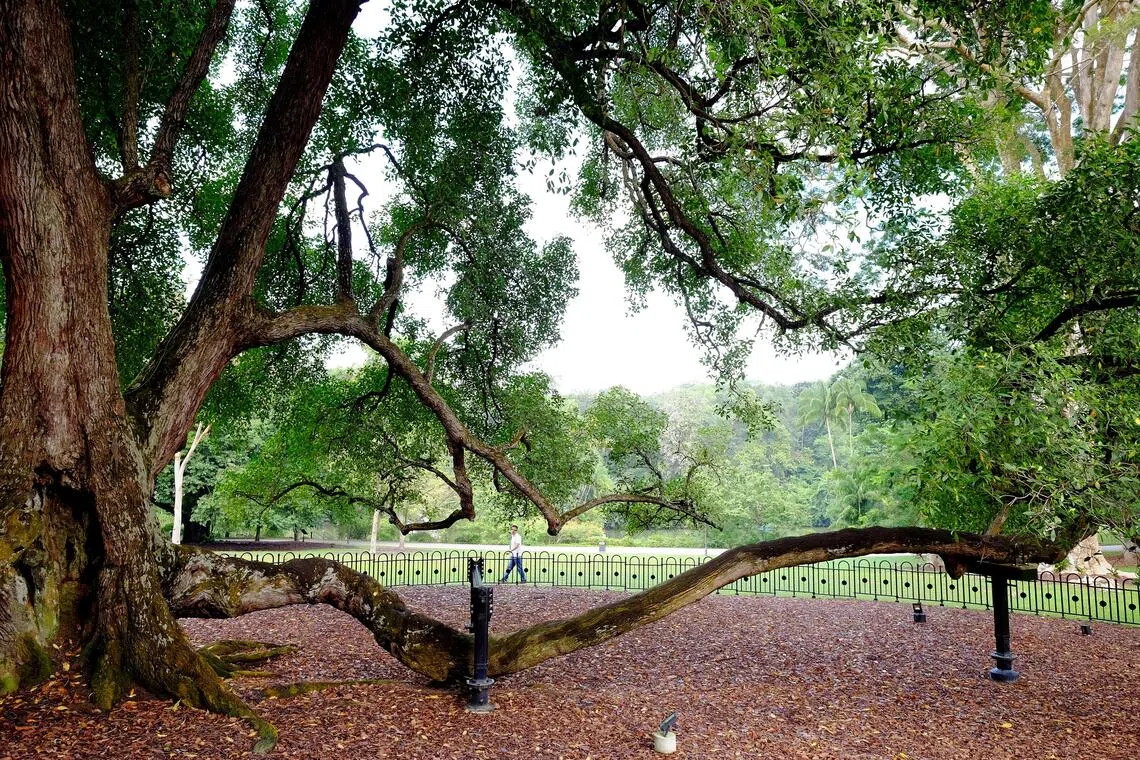
This iconic Tembusu tree is depicted on one side of the $5 Singapore note.
PHOTO: LIANHE ZAOBAO FILE
Encourage your kids to explore the Singapore Botanic Gardens to locate the Tembusu tree, the very one depicted on the $5 Singapore note.
Located on Lawn E near Swan Lake, it is easily identified by a distinctive curled, low-lying branch that sets it apart from other trees.
This Tembusu tree is believed to be at least as old as the Botanic Gardens – that is 166 years – if not more.
Established in 1859, the Botanic Gardens became Singapore’s first Unesco World Heritage Site in 2015. It is home to 62 heritage trees, among which is the iconic “$5 Tembusu tree”.

Artist Eng Siak Loy painted the tree featured on the $5 note.
ST PHOTO: STEPHANIE YEOW
Artist Eng Siak Loy, a President’s Design Award recipient and former graphics and art head for the National Parks Board (NParks), painted the tree featured on the $5 note.
The tree got so popular with visitors that NParks put a fence around it in 2013 to keep it safe. Previously, some were drawn to sitting on its low branch and walking around its base, compacting the soil over its roots.
If you are taking your kids to see it, Dr Teo suggests letting them observe, smell and draw its features. She says: “Sometimes, we don’t have to keep asking questions to encourage our children to think.”
Where: Singapore Botanic Gardens, 1 Cluny Road str.sg/EHNF
MRT: Botanic Gardens
Admission: Free
Info:
Pink axolotl in Singapore Oceanarium
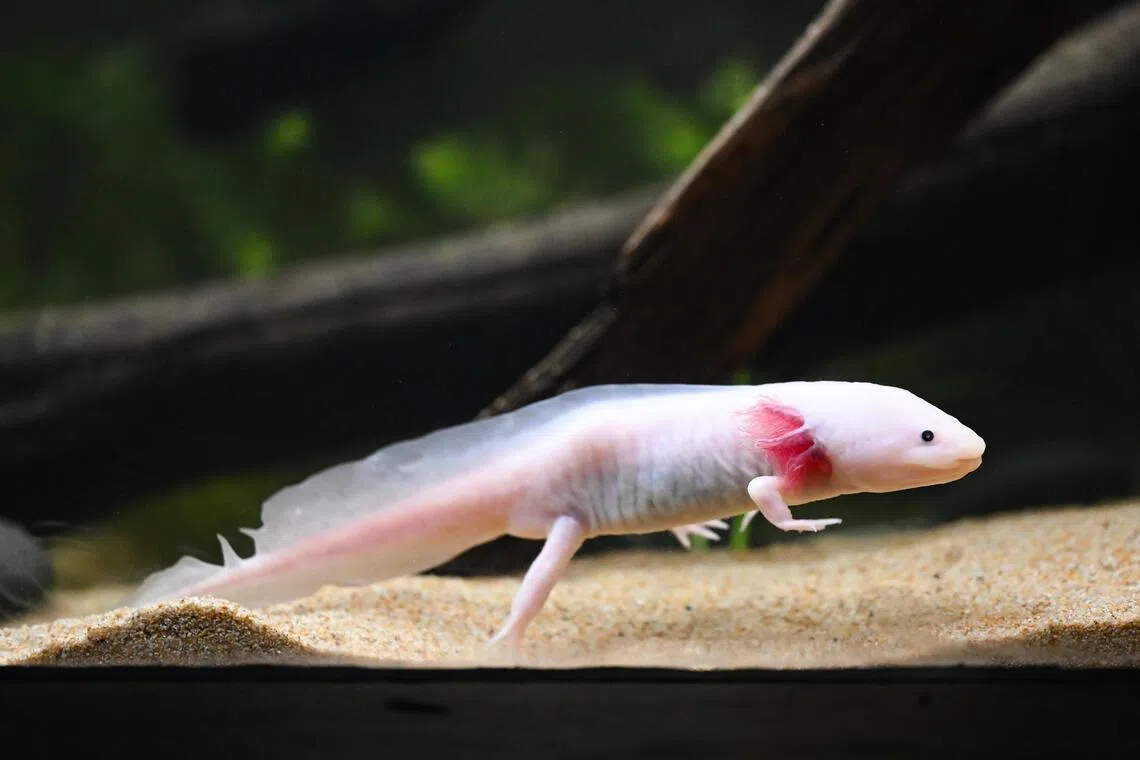
A pink axolotl at the Singapore Oceanarium’s Conquering Land zone.
ST PHOTO: LIM YAOHUI
Since its appearance in the video game Minecraft in 2021, the albino axolotl – with its pastel-pink skin and “feathery” gills that frame a seemingly smiling face – has become a viral sensation, especially among children. A catchy TikTok ditty has made it even more popular.
Now, your kids can see one in the flesh at the Singapore Oceanarium’s Conquering Land zone. Sharing its habitat is another axolotl with a mottled brown-grey body.
The oceanarium’s population sustainability manager Salam Marikan introduces the critically endangered salamander, which was rescued from the illegal pet trade.
“Our aim is to raise awareness that the commonly recognised ‘pink’ axolotls – often popularised as cute or ornamental pets – are selectively bred for aesthetic traits,” he says.
“While albinism is a naturally occurring trait, this selective breeding for the pet trade often results in only albino or leucistic individuals being sold, with natural morphs discarded.
“Such practices contribute to the illegal wildlife trade and its unethical practices, and do not represent the natural appearance or health of wild axolotls.”
By showcasing the species, it is hoped that visitors will appreciate their true beauty and understand their vital environmental role.
He says axolotls have care requirements that differ greatly from the marine animals in the oceanarium, primarily because they are freshwater amphibians, not marine species.
Their habitats are specially designed to replicate the cool, still waters of the high-altitude lakes in Mexico, where they naturally occur.
Given that they lack eyelids and their gills extend outside their body, the habitat design also considers these unique physiological needs.
Where: Singapore Oceanarium, 24 Sentosa Gateway singaporeoceanarium.com
MRT: HarbourFront
Admission: Tickets for Singapore residents start at $42 for adults and $35 for children aged four to 12, and senior citizens aged 60 and above
Info:
Sembawang Hot Spring Park

At Sembawang Hot Spring Park, your kids can cook eggs using the hot spring water.
PHOTO: NPARKS
Remember to pack eggs and buckets for your visit to Sembawang Hot Spring Park, Singapore’s only natural hot spring park, which was discovered in 1908.
Spring water at 70 deg C is available at the egg-cooking station. To make runny eggs, let them sit in your bucket of hot spring water for about 20 minutes. Take along extra eggs to experiment with different cooking times.
Here, Dr Teo suggests engaging your children by comparing the hot spring’s heat to a home kitchen stove, with questions such as: How is the heat from the hot spring similar or different from the heat from the kitchen stove? Where do you think the heat is coming from?
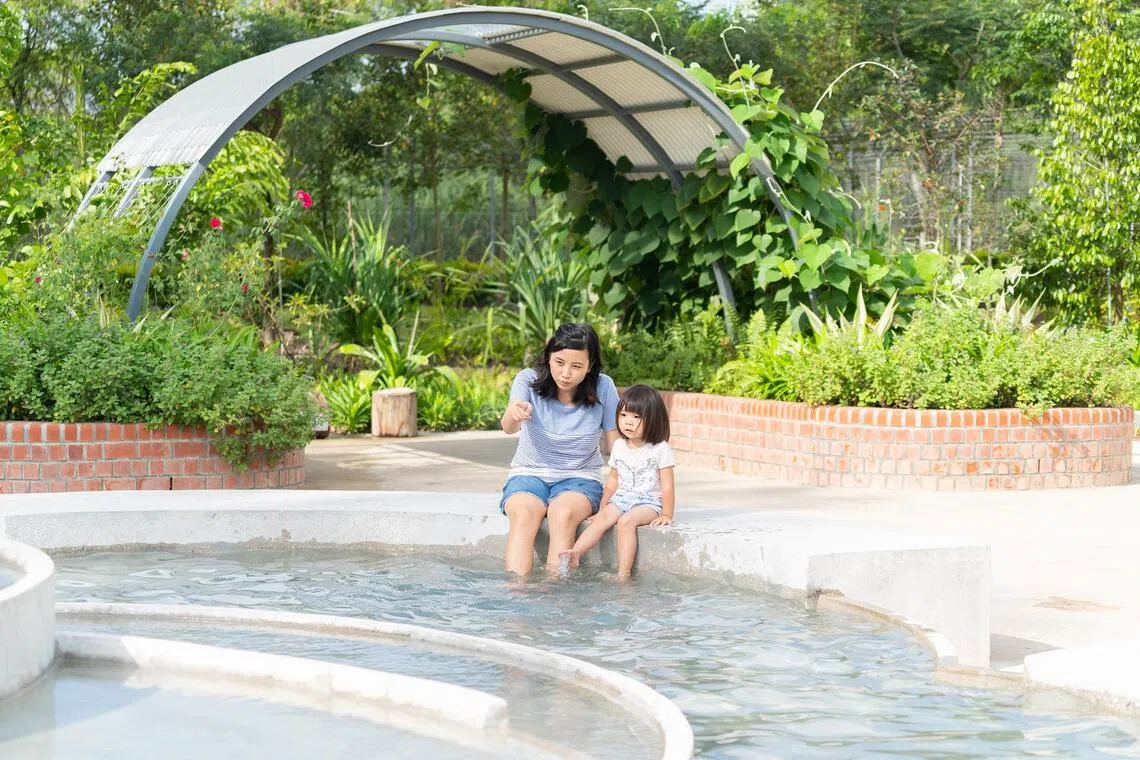
Sembawang Hot Spring Park features a cascading foot bath pool.
PHOTO: NPARKS
Another highlight is to sit at the edge of a cascading foot bath pool with your kids to soak your feet.
To make the most of your visit, read the educational signage to delve into the site’s history and the water source.
Your kids may have more questions about hot springs and geology after the visit. Take some time at home to research the answers with them online.
Where: Sembawang Hot Spring Park, Gambas Avenue str.sg/JEoKo
MRT: Canberra
Admission: Free
Info: Go to
Vegetable farm at HDB carpark

Your kids will be awestruck to discover a vegetable farm atop an HDB carpark in Tampines.
PHOTO: NATURE'S INTERNATIONAL COMMODITY
Guess what is at the top deck of this HDB carpark in Tampines? Your kids will be awestruck to discover a vegetable farm here.
Since 2019, Mr Nicholas Goh, founder of Nature’s International Commodity, has filled this 2,500 sq m area with rows of tiered planters. Among the vegetables grown here are kangkung, lettuce and xiao bai cai.
His farm allows members to harvest up to 2kg of fresh produce every Friday and Saturday morning through a $50 monthly programme. The place also doubles as a hands-on educational hub, with his team conducting tours for schools and families.
The farm’s unique story even inspired the 2024 picture book, Bala At The Urban Farm
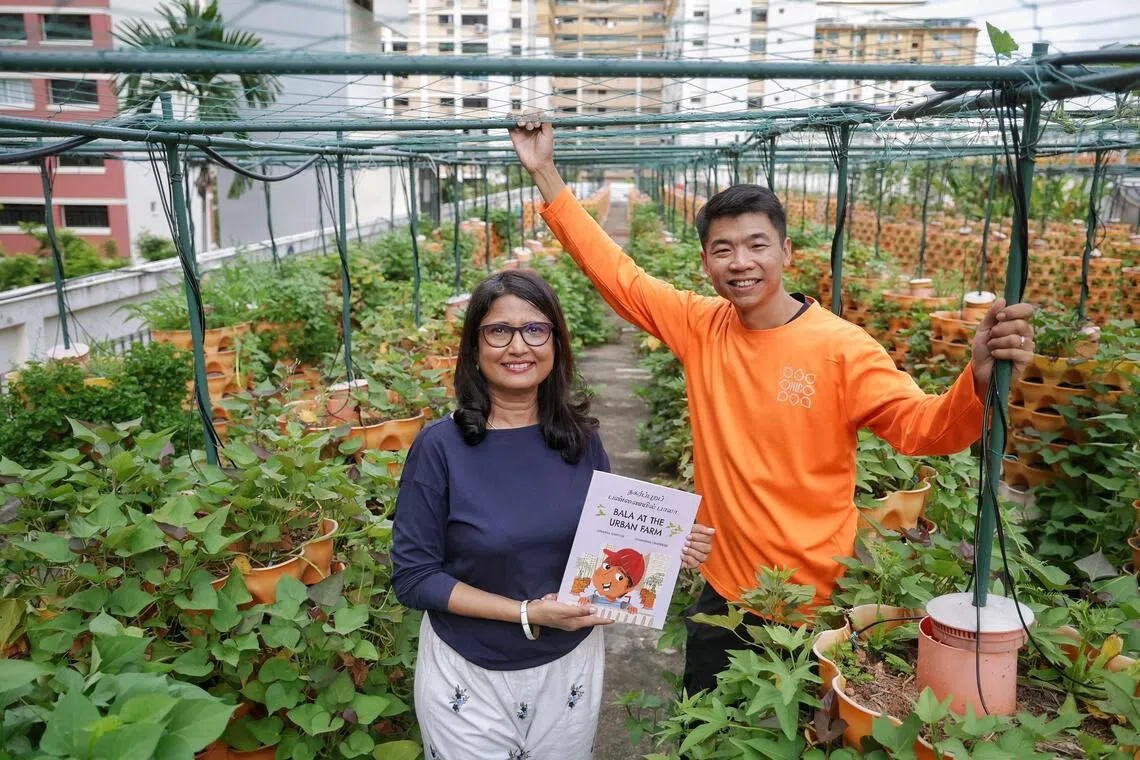
Mr Nicholas Goh's farm inspired author Junaitha Gaffoor to write the 2024 bilingual book, Bala At The Urban Farm.
PHOTO: ST FILE
Visiting a farm like this offers a valuable learning experience, as Dr Teo highlights that many children may mistakenly believe vegetables and fruit originate from supermarkets.
Encourage your kids to assist the farmers with planting seedlings so they can foster a deeper appreciation for the work involved.
During the school holidays, consider setting up a hydroponic system at home and get your kids to document its daily progress.
Where: Nature’s International Commodity, Level 5, Block 723A Tampines Street 72 fb.com/farmernicksingapore
MRT: Tampines North/Tampines
Admission: A guided tour, which includes a bag of vegetables, costs between $30 and $60 a person, depending on the group size
Info: Go to
In partnership with the National Institute of Education



